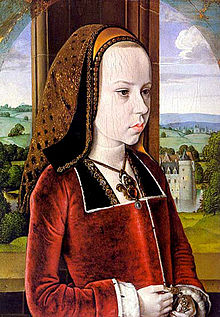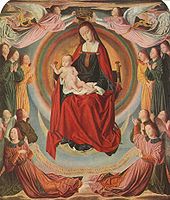- Jean Hey
-
Jean Hey (or Jean Hay) (fl. ca. 1475 – ca. 1505),[1] now generally identified with the artist formerly known as the Master of Moulins, was an Early Netherlandish painter working in France and the Duchy of Burgundy, and associated with the court of the Dukes of Bourbon.
Contents
Life and works
Little is known about Hey, whose style has led to speculation that he may have studied under Hugo van der Goes. It is possible that he spent his last years in Paris.[1]
Hey's most well-known work, the triptych in Moulins Cathedral, dates from the end of 15th century. The central panel shows the Madonna and Child adored by angels, and is flanked by portraits of the duke Pierre II and the duchess Anne de Beaujeu with their daughter Suzanne. The triptych's state of preservation is generally excellent, although at some time before the 1830s the top and bottom of the wings were trimmed (the left wing more at the bottom and the right wing more at the top).[2]
Identifying the Master of Moulins
Until the late 20th century, the name of the painter of the Moulins Triptych was unknown, although art historians identified a number of other works that were evidently by the same hand. The first monograph on the Master of Moulins, written in 1961 by Madeleine Huillet d'Istria, argued that this artist did not actually exist, and that more than 12 different artists were responsible for the corpus of works traditionally ascribed to him.[3] The Master's identity was established after an inscription was found on the reverse of a damaged painting, Christ with Crown of Thorns (1494) in the Royal Museums of Fine Arts of Belgium, Brussels, identifying the artist as Jean Hey, teutonicus and pictor egregius ("the famous painter"), and identifying the patron as Jean Cueillette, who was secretary to the King and an associate of the Bourbon family.[1][4] Stylistic similarities link this painting to the works attributed to the Master of Moulins.[4] The Master of Moulins appears to have been the court painter for the Bourbons,[5] and from a surviving account for 1502-03, it is clear that the court painter's name was Jean; other candidates once considered plausible, such as Jean Perréal and Jean Prévost, have proven untenable in the light of subsequent research.[5] The term "Teutonicus", or "German" included Flemings at this date.
Notes
References
- Brigstocke, H. (2001). The Oxford companion to Western art. Oxford: Oxford University Press. ISBN 0198662033
- Châtelet, Albert (1962). "A Plea for the Master of Moulins". The Burlington Magazine 104 (717): 517-524.
- Gowing, Lawrence (1987). Paintings in the Louvre. New York: Stewart, Tabori & Chang. ISBN 1-55670-007-5
- Reynolds, Catherine (1996). "Master of Moulins", The Dictionary of Art xx. 731-734.
- Zerner, Henri (2003). Renaissance Art in France: the invention of classicism. Paris: Flammarion. ISBN 2-0801-1144-2
External links
Categories:- Flemish painters
- Early Netherlandish painters
Wikimedia Foundation. 2010.





